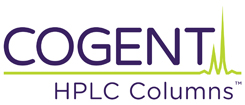Hydrolysis is a common sample degradation mechanism, which is facilitated by the presence of acids or bases in solution or on the surface of solids with which the liquid is in contact.
Certain analytical disciplines such as natural products, bio-actives and forensic science have shown that 10 to 20% of bio-active compounds may hydrolyze quantitatively “on-column” due to the conditions inside the HPLC column.
With solids in contact with liquids, the larger the surface area the greater the potential for hydrolysis. It is well known that irregular & spherical HPLC phases all have by design very high surface to volume ratios plus Si-OH groups populate the surface. Even a fully end capped traditional phase can have 30 to 50% free silanols on its surface. Using photodiode array detectors and HPLC/Mass Spec has highlighted this degradation activity.
Cogent TYPE-C Silica™ based products with silica-hydride surface (Si-H) are much less hydrolytically active than the ordinary phases with surface silanols (Si-OH) and may not hydrolyze certain compounds making it possible to detect and track injected quantities instead of the degradation products inside created in the column. This can be especially useful when seeking non targeted analytes.


